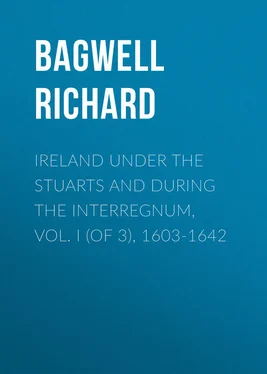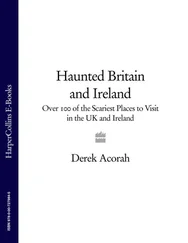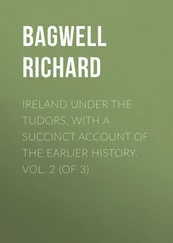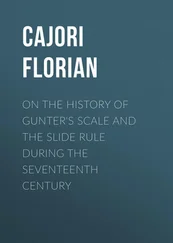Richard Bagwell - Ireland under the Stuarts and during the Interregnum, Vol. I (of 3), 1603-1642
Здесь есть возможность читать онлайн «Richard Bagwell - Ireland under the Stuarts and during the Interregnum, Vol. I (of 3), 1603-1642» — ознакомительный отрывок электронной книги совершенно бесплатно, а после прочтения отрывка купить полную версию. В некоторых случаях можно слушать аудио, скачать через торрент в формате fb2 и присутствует краткое содержание. Жанр: foreign_antique, foreign_prose, на английском языке. Описание произведения, (предисловие) а так же отзывы посетителей доступны на портале библиотеки ЛибКат.
- Название:Ireland under the Stuarts and during the Interregnum, Vol. I (of 3), 1603-1642
- Автор:
- Жанр:
- Год:неизвестен
- ISBN:нет данных
- Рейтинг книги:4 / 5. Голосов: 1
-
Избранное:Добавить в избранное
- Отзывы:
-
Ваша оценка:
- 80
- 1
- 2
- 3
- 4
- 5
Ireland under the Stuarts and during the Interregnum, Vol. I (of 3), 1603-1642: краткое содержание, описание и аннотация
Предлагаем к чтению аннотацию, описание, краткое содержание или предисловие (зависит от того, что написал сам автор книги «Ireland under the Stuarts and during the Interregnum, Vol. I (of 3), 1603-1642»). Если вы не нашли необходимую информацию о книге — напишите в комментариях, мы постараемся отыскать её.
Ireland under the Stuarts and during the Interregnum, Vol. I (of 3), 1603-1642 — читать онлайн ознакомительный отрывок
Ниже представлен текст книги, разбитый по страницам. Система сохранения места последней прочитанной страницы, позволяет с удобством читать онлайн бесплатно книгу «Ireland under the Stuarts and during the Interregnum, Vol. I (of 3), 1603-1642», без необходимости каждый раз заново искать на чём Вы остановились. Поставьте закладку, и сможете в любой момент перейти на страницу, на которой закончили чтение.
Интервал:
Закладка:
Montgomery was at once admitted by the King’s special order to the Irish Council, and events soon showed that he enjoyed a good share of royal favour. Chichester was directed to inquire by commission as to the state of ecclesiastical property in his three dioceses. The King’s letter set forth that Church lands had long been usurped by temporal lords, and until the legal tangle could be cleared no grants of Termon or abbey lands were to be made in Monaghan and Fermanagh. Davies, who at first accepted the Bishop’s claim without question, took enormous pains to understand the real nature of these Termon lands, and he seems to have come near the truth. Montgomery claimed that they were rightly the absolute property of the Church, while Tyrone and the other Irish chiefs maintained that only rents were payable, the tribal ownership with fixity of tenure belonging to the Erenachs, who had for ages been in actual possession. Thus old Miler Magrath, who had jobbed Church property so shamelessly, held Termon-Magrath, which included St. Patrick Purgatory, in succession to his father. Davies felt that his law was at fault, and after long controversies hit upon the plan of swearing in a jury of clerks or scholars to find the facts, ‘who gave them more light than ever they had before touching the original and estate of Erenachs and Termon lands.’ Of these fifteen jurors thirteen spoke Latin fluently. Their verdict was hostile to Montgomery, who contended that the Termons were episcopal demesne lands; but James, on his principle of ‘no bishop, no king,’ having asserted his claim to the forfeited property, made it all over to the Church. This was after the flight of Tyrone, but Montgomery’s proceedings may have been one cause of it. He claimed that his patent gave him everything that he or his predecessors had enjoyed, but others were for construing it strictly, and there were many suits against him upon colour of terming divers parcels of his inheritance to be monasteries, friaries, and of abbey land, and the Bishops of Clogher and Derry, where their predecessors had only chief rent, would now have the land itself. And he besought the King to stop such mean courses and make them rest content with what their predecessors had enjoyed for many years. 61 61 The King to Chichester, May 2, 1606; Bishop Montgomery to Salisbury, July 1, 1607; Chichester to Salisbury, January 26, 1607; Tyrone’s petition calendared at 1606 No. 89 with the references there; Davies to Salisbury, August 28, 1609; Todd’s St. Patrick , p. 160. The speculations of Ussher and Ware on this subject are obsolete.
Chichester’s expedition into the North in the summer of 1608 was a military promenade and an assize circuit combined, an inquiry about the escheated lands being added to the normal business. The commission included no bishop, and Montgomery, who was present during part of the circuit, made this a reason for objecting to anything being done. Davies and Ridgeway found that the Termon lands were in ‘possession of certain scholars called Erenachs, and whereof they were in ancient times true owners and proprietors, the Tyrone jury found to be vested in the Crown by the statute 11th of Elizabeth, whereby Shane O’Neill was attainted, and never since diverted by any grant from the late Queen or his Majesty.’ Montgomery claimed the Termons as demesne, and hurried over to Court with his grievance, carrying a recommendation from Chichester for the bishopric of Meath, which fell vacant at the moment. Davies took care that all the Ulster bishops should be of the next commission, but Chichester ventured to hint that Montgomery affected worldly cares too much and thought too little of reforming his clergy. 62 62 Davies to Salisbury, August 5, 1608.
On October 14, 1608, Ley and Davies left Ireland, carrying with them Chichester’s instructions as to the plantation of Ulster. He briefly described the position of Tyrone, Fermanagh, Donegal, Cavan, Armagh, and Coleraine or Londonderry, desiring them to note ‘that many of the natives in each county claim freehold in the lands they possess; and albeit their demands are not justifiable by law, yet it is hard and almost impossible to displant them.’ Even those who were tainted by rebellion should be considered, and only ‘the rest of the land’ passed to undertakers or to well-chosen servitors. The oath of supremacy was to be taken by all settlers, but some exceptions might be allowed in the case of natives who were to build houses like those in the Pale. The English and Scotch settlers were to build castles, thus securing themselves against native aggression, and the poorer officers were to be placed in the most dangerous places with small salaries to enable them to keep armed men. The natives, as less outlay was demanded from them, were required, and would be willing, to pay more rent than the settlers. The committee appointed to make arrangements in London consisted of Ley and Davies, Sir Anthony St. Leger, Sir Henry Docwra, Sir Oliver St. John, and Sir James Fullerton, with whom Bishop Montgomery was afterwards associated. They all had experience of Ulster except St. Leger, who was Master of the Rolls in Ireland, and had been a commissioner of the Munster settlement, and Fullerton, who was doubtless expected to look after the Scotch element in the business. Chichester thought it necessary to warn Salisbury about his Majesty’s partiality for his original subjects, being of opinion that Highlanders or Islemen introduced into Ulster would be more troublesome and less profitable than the Irish themselves. In about two months the London committee had got so far as to produce a detailed plan for the settlement of Tyrone, and a copy of this was sent to the Lord Deputy. 63 63 Instructions to Ley and Davies, October 14, 1608; Chichester to the King, October 15, and to Salisbury, October 18; Project of the Committee for the plantation of Tyrone, December 20.
At the beginning of 1609 the English Government printed and circulated a sort of prospectus, whereby settlers might be induced to offer themselves. Scotch and English undertakers were invited for tracts of a thousand, fifteen hundred, and two thousand acres, paying quit-rents to the Crown at the rate of six shillings and eightpence for every sixty acres, but rent-free for the first two years. It was intended that the largest grantees should hold by knight-service, but this burdensome tenure was afterwards abandoned at Chichester’s earnest prayer and common socage was everywhere substituted. The undertakers, whose portions were to be assigned by lot, were to build castles and bawns or courtyards within two years, and to have access to the royal forests for materials, being bound to keep, train and arm men enough for their defence. Chichester said that two years was not long enough to allow for the buildings, and the time was afterwards extended. Every undertaker was to take the oath of supremacy before his patent could be sealed; none might alienate to the Irish. They were to provide English or Scotch tenants only, and were tied to five years personal residence. Tenancies at will were prohibited. The servitors, generally men with some military experience, were allowed to have Irish tenants, in which case they were to pay 8 l. for every thousand acres; but where they established British tenants this was reduced to 5 l. 6 s. 8 d. Alienations to the Irish were forbidden, or to any one who would not take the oath of supremacy, the privileges and duties of the servitors being for the rest much the same as in the first case. The native Irish who formed the third class of grantees were subject, after the first year, to quit-rents twice as large as the undertakers, being subject to the same conditions as to tenures and building, but nothing was said about the oath of supremacy. Chichester knew that the natives could not as a rule build castles or bawns, and this part of the plan turned out to be unworkable. He protested from first to last that too little land was reserved to the Irish. There were further provisoes for erecting market towns and corporations, for at least one free school in every county and for a convenient number of parish churches with incumbents supported by tithes. 64 64 ‘Orders and Conditions of Plantation,’ printed in Harris’s Hibernica , p. 63, and in Hill’s Plantation in Ulster , p. 78. Project for the Plantation in Carew , dated January 23, 1608, but evidently belonging to 1608-9; it does for the other escheated counties what was done for Tyrone only in the MS. dated December 20, 1608.
Интервал:
Закладка:
Похожие книги на «Ireland under the Stuarts and during the Interregnum, Vol. I (of 3), 1603-1642»
Представляем Вашему вниманию похожие книги на «Ireland under the Stuarts and during the Interregnum, Vol. I (of 3), 1603-1642» списком для выбора. Мы отобрали схожую по названию и смыслу литературу в надежде предоставить читателям больше вариантов отыскать новые, интересные, ещё непрочитанные произведения.
Обсуждение, отзывы о книге «Ireland under the Stuarts and during the Interregnum, Vol. I (of 3), 1603-1642» и просто собственные мнения читателей. Оставьте ваши комментарии, напишите, что Вы думаете о произведении, его смысле или главных героях. Укажите что конкретно понравилось, а что нет, и почему Вы так считаете.












